Published Studies
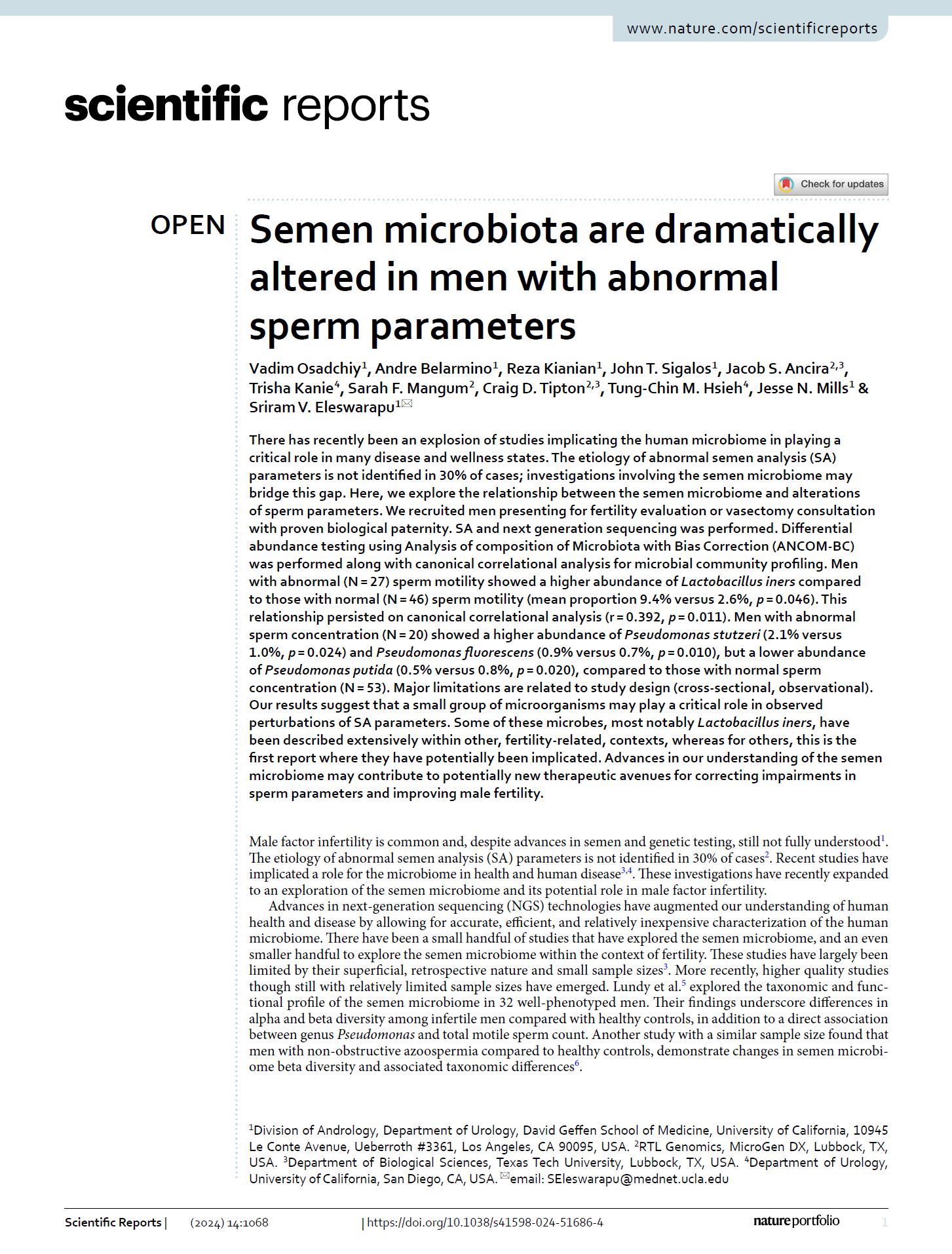
Semen Microbiota Are Dramatically Altered in Men With Abnormal Sperm Parameters
Nature.com Scientific Reports volume 14, Article number: 1068 (2024)
Study: Unveiling the Microbial Orchestra: Exploring the Intriguing Links Between Semen Microbiome and Sperm Parameters, Offering New Insights into Male Fertility Challenges. Ready Study Here
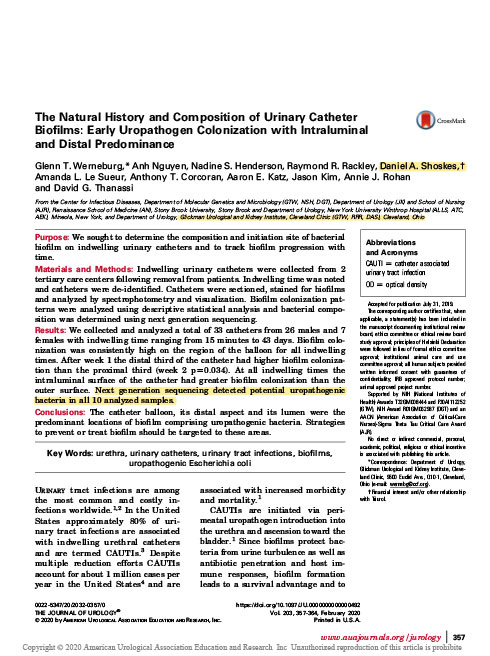
The Natural History and Composition of Urinary Catheter Biofilms: Early Uropathogen Colonization with Intraluminal and Distal Predominance
The Journal of Urology 2020 Feb;203(2):357-364
Study: We sought to determine the composition and initiation site of bacterial biofilm on indwelling urinary catheters and to track biofilm progression with time. Indwelling urinary catheters were collected from 2 tertiary care centers following removal from patients. Indwelling time was noted and catheters were de-identified. Catheters were sectioned, stained for biofilms and analyzed by spectrophotometry and visualization. Biofilm colonization patterns were analyzed using descriptive statistical analysis and bacterial composition was determined using next generation sequencing. Read Study

Detection of Bacteria by Next-Generation Sequencing in Men with Chronic Prostatitis/Chronic Pelvic Pain Syndrome: Incidence Correlation to Conventional Culture and Impact on Symptoms
The Journal of Urology Vol. 203, No. 4S, Supplement, Sunday, May 17, 2020
Study: Chronic prostatitis/
Chronic pelvic pain syndrome (CPPS) is a syndrome that shares clinical features with urinary infections and a certain subset of patients improve with antibiotics. However, traditional cultures of urine and expressed prostatic secretions often fail to identify an organism. Next-generation sequencing (NGS) analyzes microbial DNA and can identify organisms that fail to grow in traditional cultures. We sought to compare traditional cultures with NGS in men with CPPS and examine the impact on symptoms and treatment response. Read Study
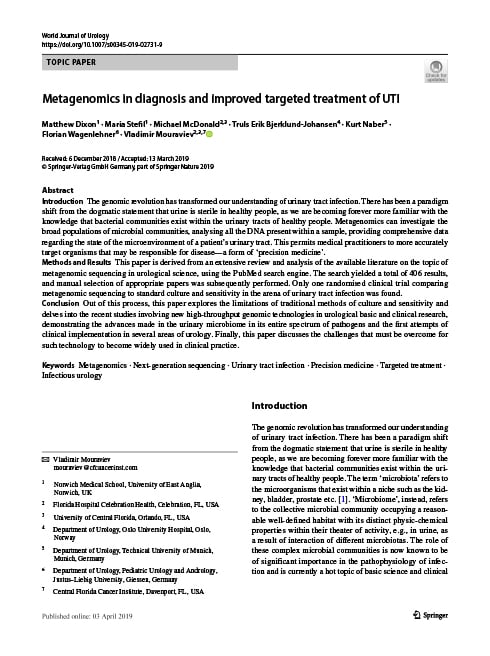
Metagenomics in diagnosis and improved targeted treatment of UTI
World J Urol. 2020;38:35–43
Review Article: An extensive publication review of metagenomic sequencing’s clinical applications in urological science – including UTI, prophylaxis prior to transrectal prostate biopsy, prostate cancer research, chronic pelvic pain syndrome, urgency urinary incontinence and neurogenic bladder management – and improved targeted treatment results. Read Article
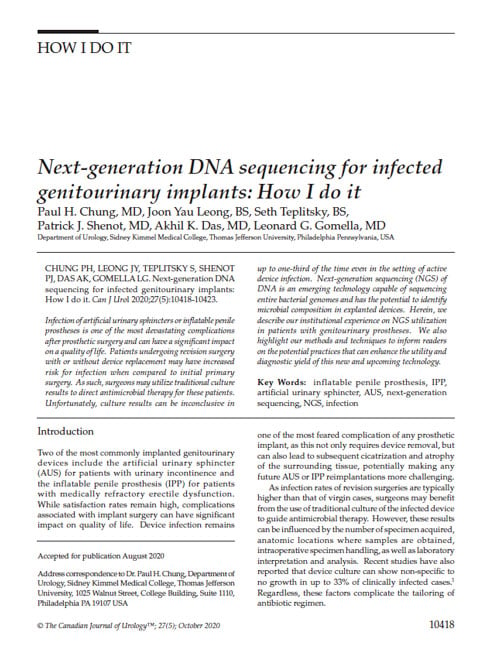
Next-Generation DNA Sequencing for Infected Genitourinary Implants: How I do it
The Canadian Journal of Urology. 27(5); October 2020
Prospective Study: Infection of artificial urinary sphincters or inflatable penile protheses is one of the most devastating complications after prosthetic surgery and can have a significant impact on a quality of life. Patients undergoing revision surgery with or without device replacement may have increased risk for infection when compared to initial primary surgery. As such, surgeons may utilize traditional culture results to direct antimicrobial therapy for these patients. Unfortunately, culture results can be inconclusive in up to one-third of the time even in the setting of active device infection. Next-generation DNA sequencing (NGS) of DNA is an emerging technology capable of sequencing entire bacterial genomes and has the potential to identify microbial composition in explanted devices. Read Study
Next Generation Sequencing for Microbial Analysis to Select Prophylactic Antibiotic Selection before Urologic Stone Surgery: A Culture Change
Open Journal of Urology Vol.11 No.7, July 2021
Article: This paper aims to determine if the combination of polymerase chain reaction (PCR) and next-generation sequencing (NGS) could identify bacteria in culture-negative urine that would alter prophylaxis management. Read Article
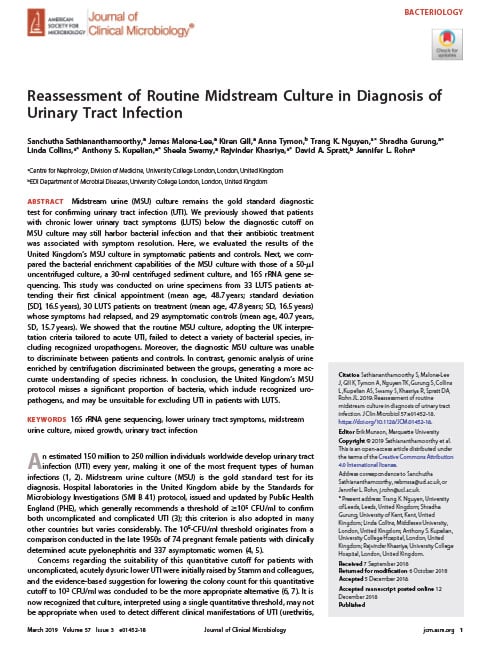
Reassessment of Routine Midstream Culture in Diagnosis of Urinary Tract Infection
Journal of Clinical Microbiology March 2019 Volume 57 Issue 3
Article: Midstream urine (MSU) culture remains the gold standard diagnostic test for confirming urinary tract infection (UTI). We previously showed that patients with chronic lower urinary tract symptoms (LUTS) below the diagnostic cutoff on MSU culture may still harbor bacterial infection and that their antibiotic treatment was associated with symptom resolution. Read Article
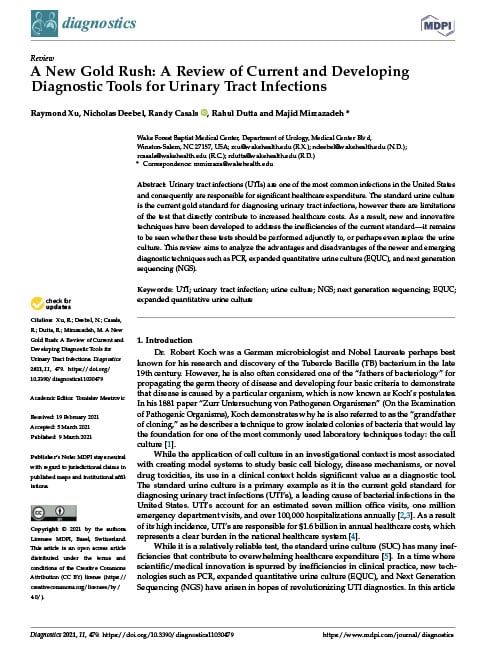
A New Gold Rush: A Review of Current and Developing Diagnostic Tools for Urinary Tract Infections
Diagnostics 2021, 11, 479
Article: Urinary tract infections (UTIs) are one of the most common infections in the United States and consequently are responsible for significant healthcare expenditure. The standard urine culture is the current gold standard for diagnosing urinary tract infections, however there are limitations of the test that directly contribute to increased healthcare costs. Read Article
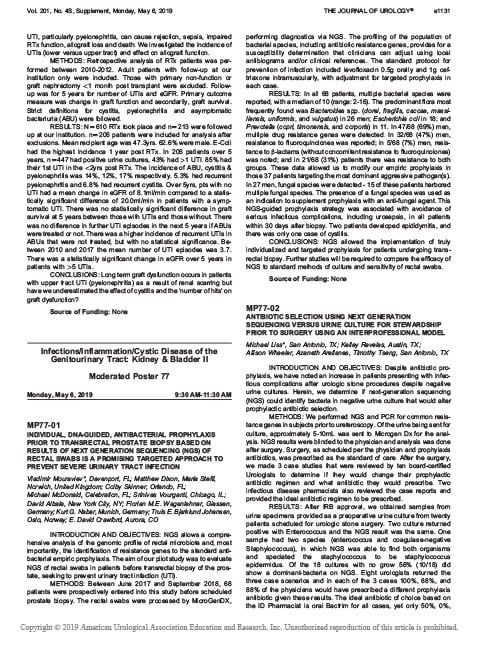
MP77-01 Individual, DNA-Guided, Antibacterial Prophylaxis Prior to Transrectal Prostate Biopsy Based on Results of Next Generation Sequencing (NGS) of Rectal Swabs is a Promising Targeted Approach to Prevent Severe Urinary Tract Infection
Journal of Urology Vol. 201, No. 4S
Article: NGS allows a comprehensive analysis of the genomic profile of rectal microbiota and, most importantly, the identification of resistance genes to the standard antibacterial empiric prophylaxis. The aim of our pilot study was to evaluate NGS of rectal swabs in patients before transrectal biopsy of the prostate, seeking to prevent urinary tract infection (UTI). Read Article

Microorganism Profiles of Penile Prosthesis Removed for Infection, Erosion, and Mechanical Malfunction Based on Next-Generation Sequencing
The Journal of Sexual Medicine 2022 Feb;19(2):356-363
Article: Background: Next-generation sequencing (NGS) is an emerging technology that may allow for more sensitive and sophisticated microbial testing of the microbiota of penile prostheses (PP).
Aim: To describe the microorganism profiles of PP explanted for infection, erosion, and mechanical malfunction using NGS. Read Article
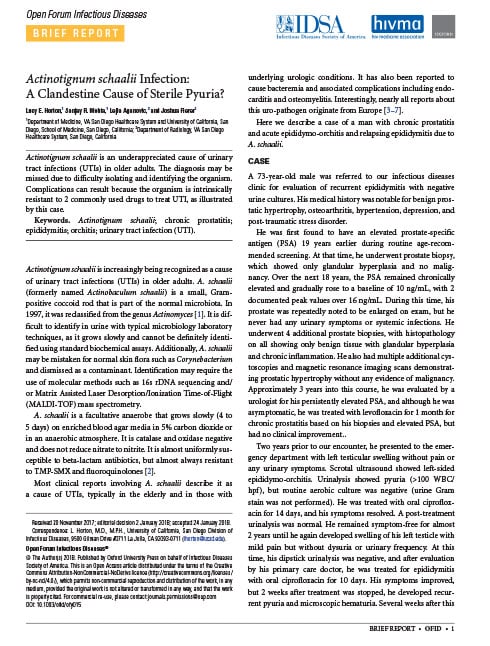
Actinotignum schaalii Infection: A Clandestine Cause of Sterile Pyuria?
Open Forum Infectious Diseases 2018 Feb; 5(2): ofy015
Article: Actinotignum schaalii is an underappreciated cause of urinary tract infections (UTIs) in older adults. The diagnosis may be missed due to difficulty isolating and identifying the organism. Complications can result because the organism is intrinsically resistant to 2 commonly used drugs to treat UTI, as illustrated by this case. Read Article
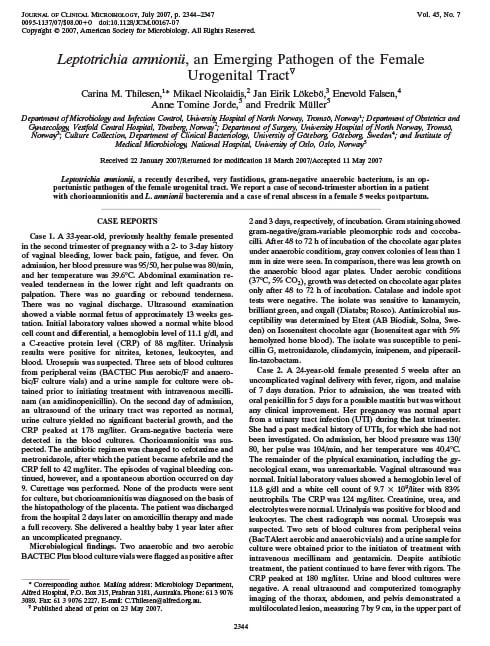
Leptotrichia amnionii, an Emerging Pathogen of the Female Urogenital Tract
Journal of Clinical Microbiology Vol. 45, No. 7
Article: Leptotrichia amnionii, a recently described, very fastidious, gram-negative anaerobic bacterium, is an opportunistic pathogen of the female urogenital tract. We report a case of second-trimester abortion in a patient with chorioamnionitis and L. amnionii bacteremia and a case of renal abscess in a female 5 weeks postpartum. Read Article
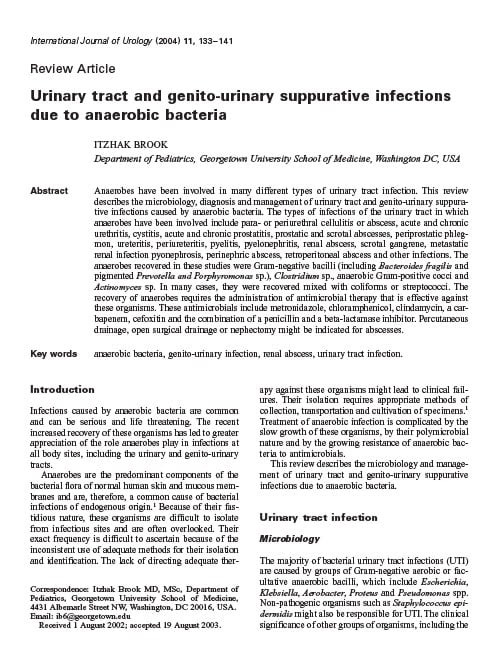
Urinary tract and genito-urinary suppurative infections due to anaerobic bacteria
International Journal of Urology 2004 Mar;11(3):133-41
Article: Anaerobes have been involved in many different types of urinary tract infection. This review describes the microbiology, diagnosis and management of urinary tract and genito-urinary suppurative infections caused by anaerobic bacteria. Read Article
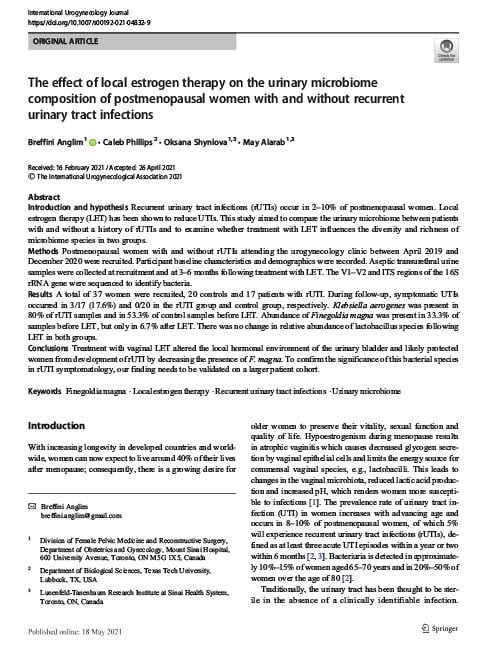
The effect of local estrogen therapy on the urinary microbiome composition of postmenopausal women with and without recurrent urinary tract infections
International Urogynecology Journal 2021 May 18
Article: Recurrent urinary tract infections (rUTIs) occur in 2-10% of postmenopausal women. Local estrogen therapy (LET) has been shown to reduce UTIs. This study aimed to compare the urinary microbiome between patients with and without a history of rUTIs and to examine whether treatment with LET influences the diversity and richness of microbiome species in two groups. Read Article
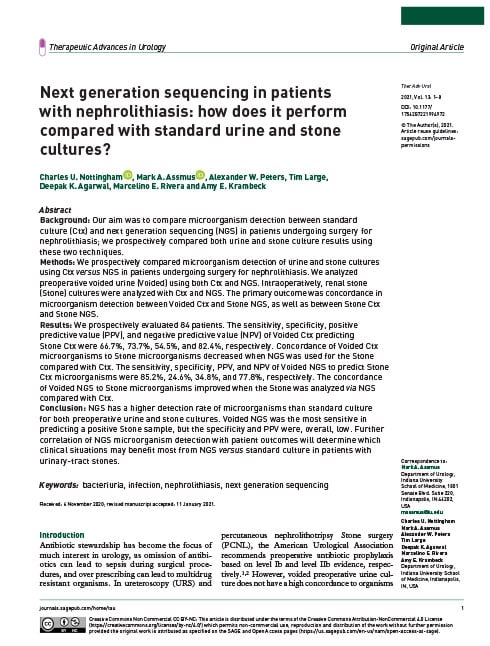
Next generation sequencing in patients with nephrolithiasis: how does it perform compared with standard urine and stone cultures?
Therapeutic Advances in Urology 2021, Vol. 13: 1–8
Article: Our aim was to compare microorganism detection between standard culture (Ctx) and next generation sequencing (NGS) in patients undergoing surgery for nephrolithiasis; we prospectively compared both urine and stone culture results using these two techniques. Read Article
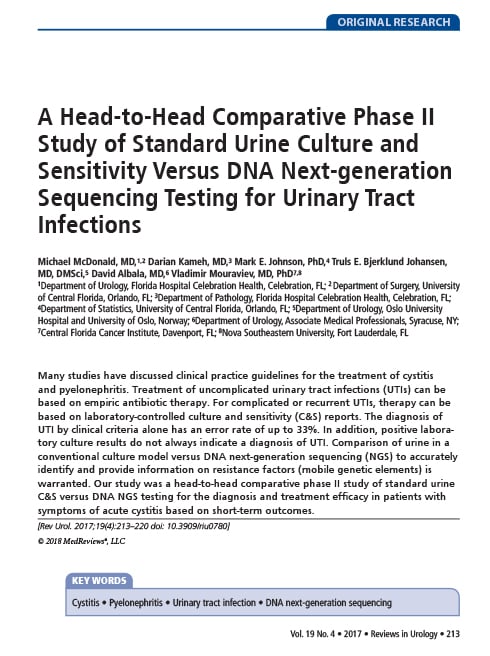
A Head-to-Head Comparative Phase II Study of Standard Urine Culture and Sensitivity Versus DNA Next-generation Sequencing Testing for Urinary Tract Infections
Rev Urol. 2017;19(4):213–220.
STUDY: 44 acute cystitis patients and 22 control group patients were treated based on either C&S or qPCR + NGS DNA sequencing results. The acute cystitis patients and the control group patients were randomly assigned to be treated either based on culture results or qPCR + NGS DNA sequencing results. On day 14, symptom scores from those treated based on qPCR + NGS DNA sequencing results were statistically better than for those treated based on culture results. Read Study
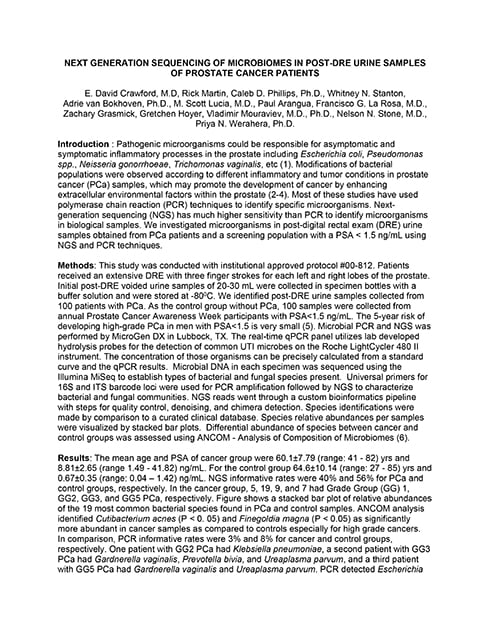
Next Generation Sequencing of Microbiomes in Post-DRE Urine Samples of Prostate Cancer Patients
University of CO 2019
ABSTRACT: Pathogenic microorganisms could be responsible for asymptomatic and symptomatic inflammatory processes in the prostate including Escherichia coli, Pseudomonas spp., Neisseria gonorrhoeae, Trichomonas vaginalis, etc (1). Modifications of bacterial populations were observed according to different inflammatory and tumor conditions in prostate cancer (PCa) samples, which may promote the development of cancer by enhancing extracellular environmental factors within the prostate (2-4). Most of these studies have used polymerase chain reaction (PCR) techniques to identify specific microorganisms. Next-generation sequencing (NGS) has much higher sensitivity than PCR to identify microorganisms in biological samples. We investigated microorganisms in post-digital rectal exam (DRE) urine samples obtained from PCa patients and a screening population with a PSA < 1.5 ng/mL using NGS and PCR techniques. Read Abstract
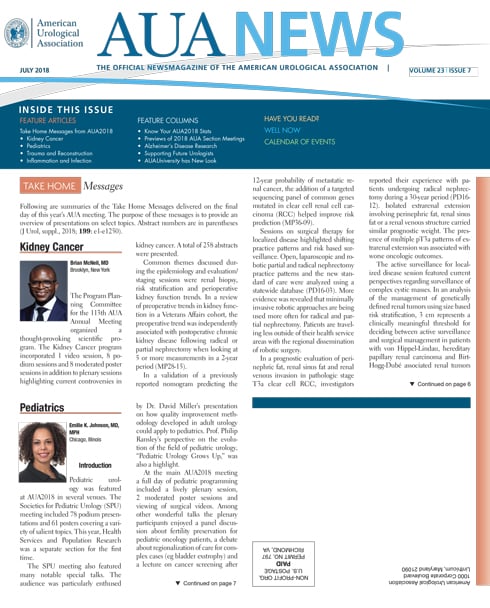
Prophylactic Antibiotics for Prostate Biopsy
AUA News VOLUME 23 | ISSUE 7
Article: The discussion regarding the best strategies for selecting prophylaxis for prostate biopsies to minimize infectious complications continued in this year’s sessions. One group reported on the use of next generation DNA sequencing to test rectal swabs for the purpose of tailoring the prebiopsy antibiotic regimen (MP15-14). Infectious complications were avoided in 23 of 24 patients, with only a single patient having cystitis 3 weeks after biopsy. Read Article
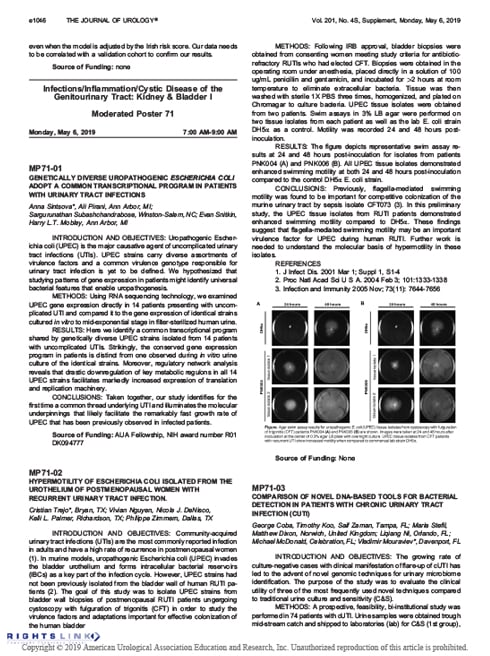
A Pilot Study to Evaluate Next Generation DNA Sequencing Testing to Rectal Swabs
European Urology Supplements Volume 16, Issue 10, November 2017, Page e2656
Meeting Abstract: The introduction of next generation sequencing (NGS) via DNA technology allows us to analyze the complete genomic profile of the gut microbiota with detection of resistance genes to the most frequently used antibiotics in empiric prophylaxis. The aim of our study was to evaluate NGS of rectal swabs prior to transrectal prostate biopsy to prevent infectious complications. Read Abstract

MP71-03 Comparison of Novel DNA-Based Tools for Bacterial Detection in Patients with Chronic Urinary Tract Infection (CUTI)
The Journal of Urology. 2019;201(4S):e1046-e1047. Supplement, Sunday, May 6, 2019.
Meeting Abstract: In a prospective, feasibility, bi-institutional study, four methods of chronic UTI microbiome identification were compared in a population of 74 chronic UTI patients using C&S, extended C&S + PCR, Volente Diagnostics, and MicroGenDX qPCR + NGS. A significant difference in accuracy was observed between C&S versus MicroGenDX. MicroGenDX identified microbes in 17 culture negative patients, and identified causative pathogens in 67 of 69 patients. The MicroGenDX methodology provided the most accurate detection of UTI pathogens over other methods. Read Abstract
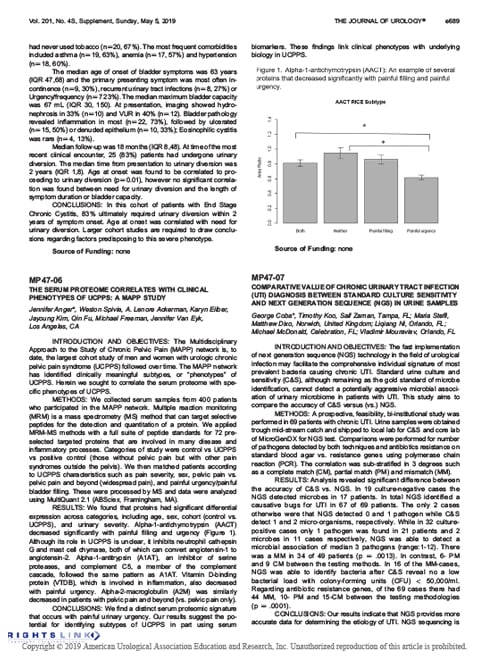
MP47-07 Comparative Value of Chronic Urinary Tract Infection (UTI) Diagnosis Between Standard Culture Sensitivity and Next Generation Sequence (NGS) in Urine Samples
The Journal of Urology. 2019;201(4S):e689. Supplement, Sunday, May 5, 2019.
Meeting Abstract: Using urine samples, the accuracy of C&S versus qPCR + NGS was compared in a 69 UTI patients in a prospective, feasibility, bi-institutional study. C&S failed to identify microbes in 17 infected patients. When compared, NGS test results were more accurate than C&S (97% versus 46%) and revealed a greater presence of polymicrobial pathogens. Read Abstract
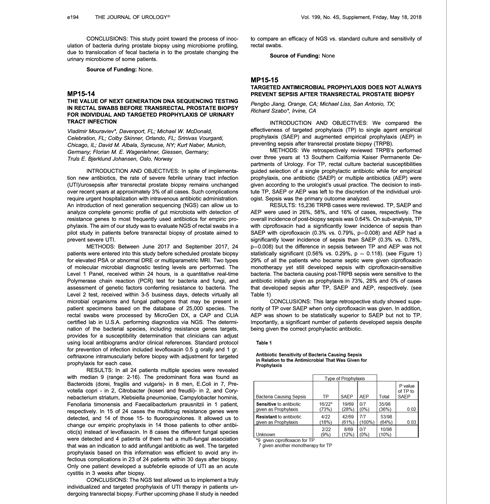
MP15-14 The value of next generation DNA sequencing testing in rectal swabs before transrectal prostate biopsy for individual and targeted prophylaxis of urinary tract infection
The Journal of Urology. 2018;199(4S):e194. Supplement, Friday, May 18, 2018.
Meeting Abstract: In a phase I study, rectal swabs from 24 patients were collected prior to transrectal prostate biopsy. Based on qPCR + NGS nucleic acid analysis, clinicians provided an individualized, targeted prophylaxis in 15 patients with multidrug resistance (14 patients with fluoroquinolone resistance). In 8 patients, different fungal species were detected, with multi-fungal associations in 4 of these. Subsequent targeted prophylaxis prevented infectious complications in 23 of the 24 patients. Read Abstract
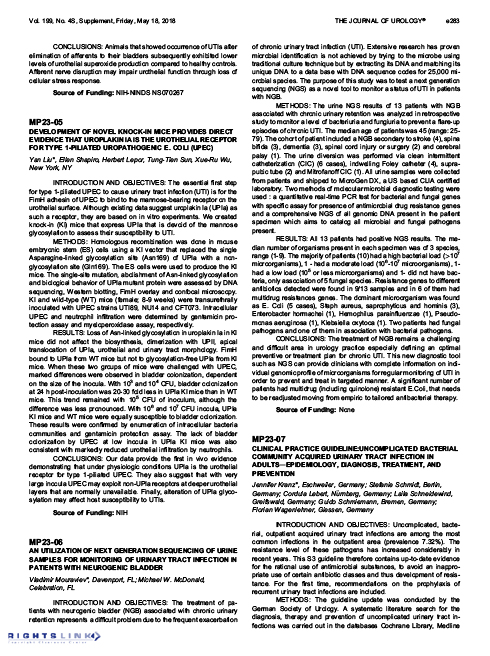
MP23-06 An utilization of next generation sequencing of urine samples for monitoring of urinary tract infections in patients with neurogenic bladder
The Journal of Urology. 2018;199(4S): e283. Supplement, Friday, May 18, 2018.
Meeting Abstract: In a retrospective study, urine-derived nucleic acid samples were assessed using qPCR + NGS to monitor 13 neurogenic bladder patients. All 13 patients had between 1 and 9 microorganisms present, 10 with a high bacterial load and one with 5 fungal species. Nine patients had antibiotic resistance genes, with 6 having multidrug resistance. Significantly, quinolone resistant E.coli was present in many of the patients, suggesting a required change from empiric therapy to a tailored treatment protocol. Read Abstract
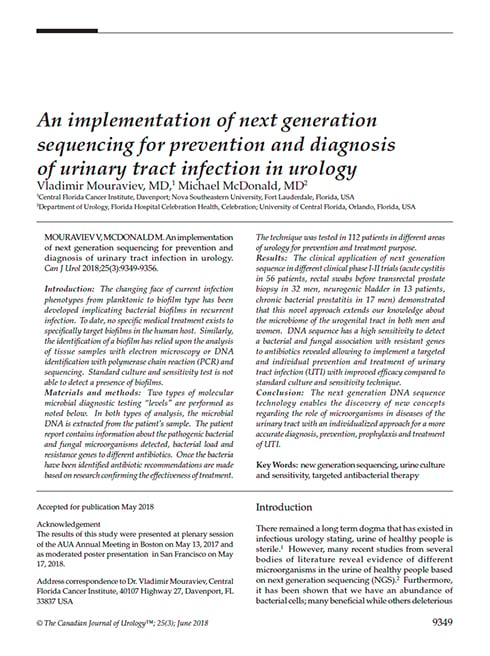
An implementation of next generation sequencing for prevention and diagnosis of urinary tract infection in urology
Can J Urol. 2018;25(3):9349-9356.
STUDY: qPCR + NGS was used to identify bacterial and fungal pathogens in 112 UTI patients (acute cystitis, rectal swabs before transrectal prostate biopsy, neurogenic bladder, and chronic bacterial prostatitis). In comparison to culture analysis, qPCR + NGS patients experienced superior targeted treatment outcomes related to detection of resistance genes and anaerobic and culture-independent pathogens. Read Study
